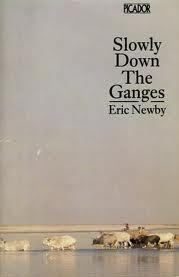
Slowly down the Ganges
For those that are lucky enough to have lived in or visited India, I am sure they would agree that Newby’s vivid descriptions of the landscape and the mix of culture and customs offer a compelling portrait of the country. For those that are yet to set foot on Indian soil, I highly recommend that you dip your toe in with Slowly Down the Ganges.
Accompanied by his life-long travel companion and wife, Wanda, Newby sets off on a 1,200 mile journey from Hardwar, where the Ganges enters the great plain, down to the Bay of Bengal. Newby documents their journey as they travel by boat, train, bus and bullock cart, overcoming numerous obstructions (both physical and metaphorical) as they meander the course of this famous river.
The first few chapters of the book are peppered with frustration as, following a lengthy process to secure a boat, Newby and his crew find themselves run-aground on multiple occasions (63 times to be exact). In these opening pages, both Newby and the reader quickly realise that this journey is very much at the mercy of the Ganges. With each open and navigable stretch, Newby’s optimism renews, only to find themselves once again ‘glued to the bottom’ of the river bed. In spite of his obvious impatience, the author maintains a trademark sense of humour, only noticing that they were making progress by the fact that the rocks under foot were becoming ‘more difficult to lift and more painful to stand on’.
Whilst the start of the journey is slow, it does allow Newby to make the most of his surroundings. He offers lively descriptions of the goings-on on the river banks, stopping at Raoli, a small village just outside of Bijnor, where, upon disembarking from the boat, they are immediately invited to a wedding. He describes the feeling of ‘excitement and apprehension’ as they joined the crowds, relaying to the reader the sheer volume emitting from the wedding guests, the band and even the ‘myriad frogs’ perched on the river banks. His vivid descriptions of noise, colour and food emphasise the unique hospitality that he found in bankside villages, even culminating their evening with a spin in the wedding chariot, something that their hosts were ‘delighted’ to accommodate.
The descriptions of life on and around the Ganges is compelling, but so too are the detailed portraits of the crew that accompany Newby on his travels. Karam Chand, the chief boatman, is given significant air time, becoming a devoted companion to Newby and remaining seemingly unfazed by the tribulations of their journey. Indeed, with each set-back, whilst the rest of the group becomes increasingly frustrated, Chand appears ‘completely happy’ for the extension to their travels. The author also provides an insight into the nature of his marriage in relaying Wanda’s experiences and reactions to her surroundings. These become some of the most humorous aspects of the book as the long-suffering Wanda is left to guard belongings against bears, is ridiculed for her dislike of onions, and at one point has a rather unpleasant bout of food poising (something that I imagine she would rather have not had intricately documented in a travel book).
As they progress in their journey, Newby meditates on the importance of the river not just to those who live there, but to millions in India and beyond. He visits numerous sacred places, including outcrops shaped by the feet of the gods, pilgrimage sites and temples. He lists the 108 different names for the Ganges, from ‘Bahu-ksira’ (a cow which gives much milk) to ‘Ajnana-timira-bhanu’ (a light amid the darkness of ignorance). He describes the river to be something of a lifeline to the country, not just for the surprising purity of the water and the fertility of the area surrounding it, but for the spiritual cleansing that it offers.
Slowly Down the Ganges is an engaging account of life in northern India in the 1960s, painting vivid pictures of the surrounding landscapes, as well as those characters that live and thrive there. The book showcases Newby at his best, with wit and character coming through in his accounts. It is this that carries the reader so seamlessly along as he completes his own pilgrimage down the Ganges.
Camilla Bryden
April 2021
